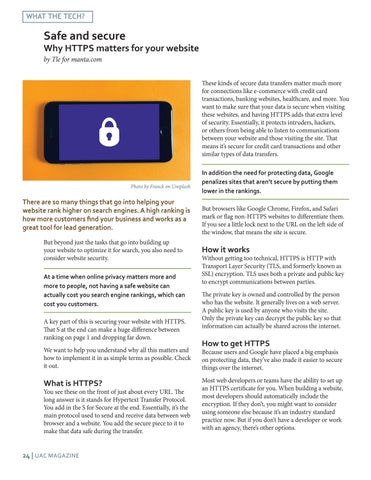WHAT THE TECH?
Safe and secure
Why HTTPS matters for your website by Tle for manta.com These kinds of secure data transfers matter much more for connections like e-commerce with credit card transactions, banking websites, healthcare, and more. You want to make sure that your data is secure when visiting these websites, and having HTTPS adds that extra level of security. Essentially, it protects intruders, hackers, or others from being able to listen to communications between your website and those visiting the site. That means it’s secure for credit card transactions and other similar types of data transfers.
Photo by Franck on Unsplash
There are so many things that go into helping your website rank higher on search engines. A high ranking is how more customers find your business and works as a great tool for lead generation. But beyond just the tasks that go into building up your website to optimize it for search, you also need to consider website security. At a time when online privacy matters more and more to people, not having a safe website can actually cost you search engine rankings, which can cost you customers. A key part of this is securing your website with HTTPS. That S at the end can make a huge difference between ranking on page 1 and dropping far down. We want to help you understand why all this matters and how to implement it in as simple terms as possible. Check it out.
What is HTTPS?
You see these on the front of just about every URL. The long answer is it stands for Hypertext Transfer Protocol. You add in the S for Secure at the end. Essentially, it’s the main protocol used to send and receive data between web browser and a website. You add the secure piece to it to make that data safe during the transfer.
24 | UAC MAGAZINE
In addition the need for protecting data, Google penalizes sites that aren’t secure by putting them lower in the rankings. But browsers like Google Chrome, Firefox, and Safari mark or flag non-HTTPS websites to differentiate them. If you see a little lock next to the URL on the left side of the window, that means the site is secure.
How it works
Without getting too technical, HTTPS is HTTP with Transport Layer Security (TLS, and formerly known as SSL) encryption. TLS uses both a private and public key to encrypt communications between parties. The private key is owned and controlled by the person who has the website. It generally lives on a web server. A public key is used by anyone who visits the site. Only the private key can decrypt the public key so that information can actually be shared across the internet.
How to get HTTPS
Because users and Google have placed a big emphasis on protecting data, they’ve also made it easier to secure things over the internet. Most web developers or teams have the ability to set up an HTTPS certificate for you. When building a website, most developers should automatically include the encryption. If they don’t, you might want to consider using someone else because it’s an industry standard practice now. But if you don’t have a developer or work with an agency, there’s other options.
















